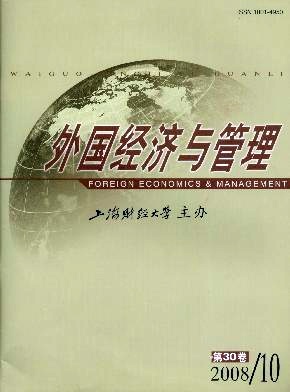家族社会资本与创业机会识别问题探讨
外国经济与管理 2008 年 第 30 卷第 10 期, 页码:25 - 31
摘要
参考文献
摘要
本文结合国外的相关研究,通过对家族社会资本这一概念的界定与分类,从一个崭新的视角考察了家族嵌入与家族社会资本对创业机会识别的影响,并提出了若干可供今后研究参考的命题。
[1]Kirzner,I M.Entrepreneurial discovery andthe competitive market process:An Austrian approach[J].Journal of Economic Literature,1997,35(1):60-85.
[2]Hulbert,B,Brown,R B,and Adams,S.Towards an understanding of“opportunity”[J].Marketing Education Review,1997,3(10):67-73.
[3]Ardichvili,A,Cardozob,R,and Ray,S.Atheory of entrepreneurial opportunity identification and development[J].Journal of BusinessVenturing,2003,18:105-123.
[4]Shane,S,and Venkataraman,S.The promise of entrepreneurship as a field of research[J].Academy of Management Review,2000,25(1):217-226.
[5]Lindsay,J,and Craig,J.Aframework for understanding opportunity recognition:Entrepreneurs versus private equity financiers[J].Journal of Private Equity,2002,5(6):13-24.
[6]Granovetter,M.Economic action and social structure:The problemof embeddedness[J].American Journal of Sociology,1985,91:481-510.
[7]Aldrich,HE,and Cliff,J E.The pervasive effects of family on entrepreneurship:Toward a family embeddedness perspective[J]Journalof Business Venturing,2003,18:573-596.
[8]Kellermanns,F W,and Eddleston,K A.Corporate entrepreneurshipinfamily firms:Afamily perspective[J].Entrepreneurship Theoryand Practice,2006,30(10):809-830.
[9]Barney,J B,Clark,D,and Alvarez,S.Where does entrepreneurship come from?Network models of opportunity recognition and re-source acquisition with application to the family firm[R].Paper Presented at the Theories of the Family Enterprise Conference,Uni-versity of Pennsylvania,Philadelphia,2003.
[10]Salvato,C.Predictors of entrepreneurshipin family firms[J].Journal of Private Equity,2004,7(3):68-76.
[11]Granovetter,M.The strength of weak ties[J].American Journal of Sociology,1973,(6):1 360-1 380.
[12]Carney,M.Corporate governance and competitive advantage in family-controlled firms[J].Entrepreneurship Theory and Practice,2005,29(3):249-263.
[13]M D Le Breton-Miller.Challenge and advantage in family business[J].Strategic Organization,2003,1(1):127-134.
[14]Zahra,S A,Hayton,J C,and Salvato,C.Entrepreneurshipinfamily vs.non-familyfirms:Aresource-based analysis of the effect of or-ganizational culture[J].Entrepreneurship Theory and Practice,2004,28(4):363-381.
[15]Heck,R.Acommentary on“entrepreneurshipin family vs.non-family firms:Aresource-based analysis of the effect of organizationalculture”[J].Entrepreneurship Theory and Practice,2004,28(4):383-389.
[16]Hall,A,Melin,L,and Nordqvist,M.Entrepreneurship as radical change in family business:Exploring the role of cultural patterns[J].Family Business Review,2001,14(3):193-208.
[2]Hulbert,B,Brown,R B,and Adams,S.Towards an understanding of“opportunity”[J].Marketing Education Review,1997,3(10):67-73.
[3]Ardichvili,A,Cardozob,R,and Ray,S.Atheory of entrepreneurial opportunity identification and development[J].Journal of BusinessVenturing,2003,18:105-123.
[4]Shane,S,and Venkataraman,S.The promise of entrepreneurship as a field of research[J].Academy of Management Review,2000,25(1):217-226.
[5]Lindsay,J,and Craig,J.Aframework for understanding opportunity recognition:Entrepreneurs versus private equity financiers[J].Journal of Private Equity,2002,5(6):13-24.
[6]Granovetter,M.Economic action and social structure:The problemof embeddedness[J].American Journal of Sociology,1985,91:481-510.
[7]Aldrich,HE,and Cliff,J E.The pervasive effects of family on entrepreneurship:Toward a family embeddedness perspective[J]Journalof Business Venturing,2003,18:573-596.
[8]Kellermanns,F W,and Eddleston,K A.Corporate entrepreneurshipinfamily firms:Afamily perspective[J].Entrepreneurship Theoryand Practice,2006,30(10):809-830.
[9]Barney,J B,Clark,D,and Alvarez,S.Where does entrepreneurship come from?Network models of opportunity recognition and re-source acquisition with application to the family firm[R].Paper Presented at the Theories of the Family Enterprise Conference,Uni-versity of Pennsylvania,Philadelphia,2003.
[10]Salvato,C.Predictors of entrepreneurshipin family firms[J].Journal of Private Equity,2004,7(3):68-76.
[11]Granovetter,M.The strength of weak ties[J].American Journal of Sociology,1973,(6):1 360-1 380.
[12]Carney,M.Corporate governance and competitive advantage in family-controlled firms[J].Entrepreneurship Theory and Practice,2005,29(3):249-263.
[13]M D Le Breton-Miller.Challenge and advantage in family business[J].Strategic Organization,2003,1(1):127-134.
[14]Zahra,S A,Hayton,J C,and Salvato,C.Entrepreneurshipinfamily vs.non-familyfirms:Aresource-based analysis of the effect of or-ganizational culture[J].Entrepreneurship Theory and Practice,2004,28(4):363-381.
[15]Heck,R.Acommentary on“entrepreneurshipin family vs.non-family firms:Aresource-based analysis of the effect of organizationalculture”[J].Entrepreneurship Theory and Practice,2004,28(4):383-389.
[16]Hall,A,Melin,L,and Nordqvist,M.Entrepreneurship as radical change in family business:Exploring the role of cultural patterns[J].Family Business Review,2001,14(3):193-208.
引用本文
陈文婷, 何轩. 家族社会资本与创业机会识别问题探讨[J]. 外国经济与管理, 2008, 30(10): 25–31.
导出参考文献,格式为:





 6368
6368  902
902

